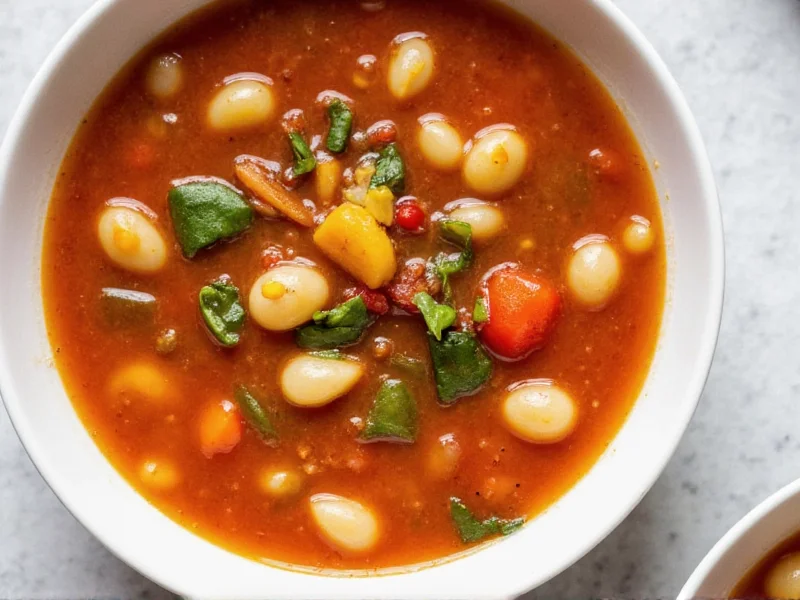Minestrone soup represents one of Italy's most beloved culinary traditions—a flexible peasant dish born from resourcefulness that transforms seasonal vegetables into a nourishing meal. Unlike many simplified versions, authentic minestrone balances rich vegetable flavors with a savory tomato base and aromatic herbs, creating a complex broth that satisfies without meat. This tested recipe delivers the perfect texture: tender but not mushy vegetables, al dente pasta, and a deeply flavorful broth that improves overnight.
The Essential Minestrone Components
Traditional minestrone varies by region and season, but certain elements remain constant. The soffritto—Italy's flavor foundation of onions, carrots, and celery—creates the soup's aromatic base. Quality canned tomatoes provide consistent acidity and sweetness year-round, while homemade vegetable broth enhances depth without overpowering delicate ingredients. The addition of cannellini beans adds protein and creaminess, making this a complete meal.
| Prep Time | Cook Time | Total Time | Servings |
|---|---|---|---|
| 15 minutes | 40 minutes | 55 minutes | 6 |
Ingredient Breakdown and Substitutions
Understanding each component's role ensures successful minestrone every time. Don't substitute haphazardly—each ingredient serves a specific purpose in the flavor profile.
- Soffritto (1 onion, 2 carrots, 2 celery stalks): Finely diced and sautéed slowly to release natural sugars without browning
- Garlic (3 cloves): Added after soffritto to prevent burning; provides aromatic depth
- Canned tomatoes (28oz whole peeled): San Marzano varieties preferred for balanced acidity
- Vegetable broth (6 cups): Homemade preferred; low-sodium store-bought acceptable
- Seasonal vegetables (zucchini, green beans, cabbage): 2-3 types depending on season; cut uniformly
- Cannellini beans (15oz can): Rinsed; adds creaminess and protein
- Ditalini pasta (¾ cup): Small tube pasta that holds shape during cooking
- Parmesan rind (optional): Adds umami depth without saltiness
- Fresh basil and parsley: Stirred in at end for bright finish
Step-by-Step Cooking Method
Proper technique separates exceptional minestrone from ordinary vegetable soup. Follow these critical steps for authentic results:
- Sauté soffritto: Cook onions, carrots, and celery in olive oil over medium-low heat for 8-10 minutes until translucent but not browned
- Add aromatics: Stir in minced garlic and tomato paste; cook 1 minute until fragrant
- Build broth: Add tomatoes (crushing by hand), broth, parmesan rind, and hard vegetables (carrots, celery); simmer 15 minutes
- Add remaining vegetables: Incorporate zucchini, green beans, and cabbage; cook 10 minutes
- Cook pasta separately: Boil ditalini until al dente; rinse and add to soup just before serving to prevent mushiness
- Finish with beans and herbs: Stir in rinsed beans and fresh herbs; adjust seasoning
Avoiding Common Minestrone Mistakes
Even experienced cooks make these critical errors that compromise authentic flavor:
- Rushing the soffritto: Properly cooked soffritto should be soft and sweet, not browned or caramelized
- Overcooking pasta: Cook pasta separately and add at serving to maintain texture
- Using dried herbs: Fresh basil and parsley added at the end provide essential brightness
- Skipping the parmesan rind: This traditional ingredient adds depth without saltiness
- Overloading vegetables: Too many types dilutes flavor; 3-4 seasonal vegetables work best
Seasonal Variations and Dietary Adaptations
True minestrone changes with the seasons, reflecting available produce. In spring, use asparagus and peas; summer features tomatoes and zucchini; fall incorporates squash and kale; winter relies on root vegetables and cabbage. For dietary needs:
- Gluten-free: Substitute gluten-free pasta or omit entirely, adding extra beans for heartiness
- Vegan: Omit parmesan rind; use nutritional yeast for umami depth
- Lower carbohydrate: Replace pasta with chopped kale or chard added in the last 5 minutes
- Protein boost: Add ½ cup cooked lentils with the beans for additional plant-based protein
Serving and Storage Guidelines
Minestrone tastes best when flavors have time to meld. For optimal results:
- Let soup rest 30 minutes before serving to allow flavors to integrate
- Serve with extra virgin olive oil drizzle and freshly grated parmesan
- Store in airtight container for up to 5 days in refrigerator
- Freeze without pasta for up to 3 months; add fresh pasta when reheating
- Reheat gently on stove—never boil vigorously which breaks down vegetables
Frequently Asked Questions
Can I make minestrone soup without tomatoes?
Yes, though tomatoes provide traditional acidity. Substitute with 2 tablespoons red wine vinegar added at the end, or use roasted red peppers blended into the broth for similar depth without tomato flavor.
Why does my minestrone taste bland?
Bland minestrone typically results from under-seasoned broth or vegetables added too early. Always season in layers: salt the soffritto, season the broth, and adjust final seasoning after all vegetables are cooked. A parmesan rind during cooking adds essential umami depth.
How do I prevent pasta from becoming mushy in minestrone?
Cook pasta separately until al dente, rinse under cold water, and add to individual bowls just before serving. This technique maintains perfect texture, especially important for leftovers. Never cook pasta directly in the soup broth if you plan to have leftovers.
What's the difference between minestrone and vegetable soup?
Minestrone features a soffritto base, tomato component, beans, and pasta in a broth that develops layered flavors through proper technique. Vegetable soup often lacks the aromatic foundation and structured cooking process, resulting in less complex flavor. Minestrone also traditionally includes a parmesan rind for depth.
Can I use frozen vegetables in minestrone?
While fresh seasonal vegetables yield best results, frozen green beans or peas work well when added during the last 5 minutes of cooking. Avoid frozen carrots, celery, or onions as they become mushy. Never use frozen tomatoes—they release too much water and dilute flavor.











 浙公网安备
33010002000092号
浙公网安备
33010002000092号 浙B2-20120091-4
浙B2-20120091-4